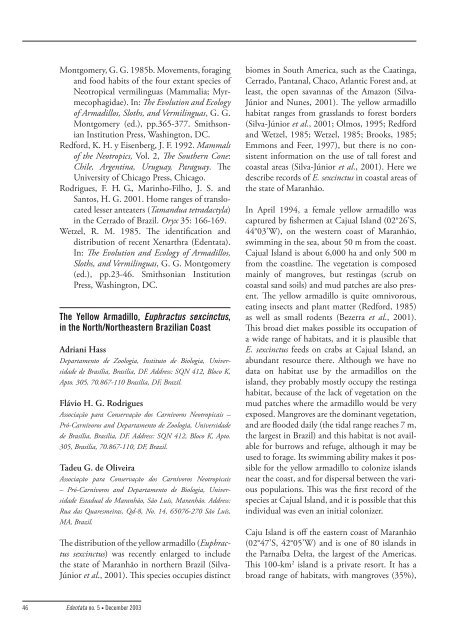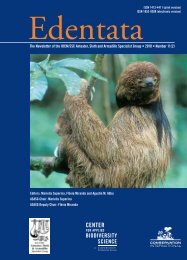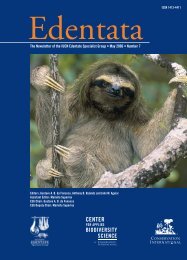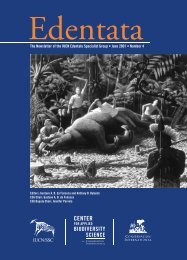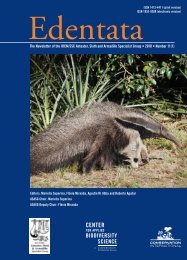Montgomery, G. G. 1985b. Movements, foragingand food habits of the four extant species ofNeotropical vermilinguas (Mammalia; Myrmecophagidae).In: e Evolution and Ecologyof <strong>Armadillo</strong>s, <strong>Sloth</strong>s, and Vermilinguas, G. G.Montgomery (ed.), pp.365-377. SmithsonianInstitution Press, Washington, DC.Redford, K. H. y Eisenberg, J. F. 1992. Mammalsof the Neotropics, Vol. 2, e Southern Cone:Chile, Argentina, Uruguay, Paraguay. eUniversity of Chicago Press, Chicago.Rodrigues, F. H. G., Marinho-Filho, J. S. andSantos, H. G. 2001. Home ranges of translocatedlesser anteaters (Tamandua tetradactyla)in the Cerrado of Brazil. Oryx 35: 166-169.Wetzel, R. M. 1985. e identification anddistribution of recent Xenarthra (<strong>Edentata</strong>).In: e Evolution and Ecology of <strong>Armadillo</strong>s,<strong>Sloth</strong>s, and Vermilinguas, G. G. Montgomery(ed.), pp.23-46. Smithsonian InstitutionPress, Washington, DC.The Yellow <strong>Armadillo</strong>, Euphractus sexcinctus,in the North/Northeastern Brazilian CoastAdriani HassDepartamento de Zoologia, Instituto de Biologia, Universidadede Brasília, Brasília, DF. Address: SQN 412, Bloco K,Apto. 305, 70.867-110 Brasília, DF, Brazil.Flávio H. G. RodriguesAssociação para Conservação dos Carnívoros Neotropicais –Pró-Carnívoros and Departamento de Zoologia, Universidadede Brasília, Brasília, DF. Address: SQN 412, Bloco K, Apto.305, Brasília, 70.867-110, DF, Brazil.Tadeu G. de OliveiraAssociação para Conservação dos Carnívoros Neotropicais– Pró-Carnívoros and Departamento de Biologia, UniversidadeEstadual do Maranhão, São Luís, Maranhão. Address:Rua das Quaresmeiras, Qd-8, No. 14, 65076-270 São Luís,MA, Brazil.e distribution of the yellow armadillo (Euphractussexcinctus) was recently enlarged to includethe state of Maranhão in northern Brazil (Silva-Júnior et al., 2001). is species occupies distinctbiomes in South America, such as the Caatinga,Cerrado, Pantanal, Chaco, Atlantic Forest and, atleast, the open savannas of the Amazon (Silva-Júnior and Nunes, 2001). e yellow armadillohabitat ranges from grasslands to forest borders(Silva-Júnior et al., 2001; Olmos, 1995; Redfordand Wetzel, 1985; Wetzel, 1985; Brooks, 1985;Emmons and Feer, 1997), but there is no consistentinformation on the use of tall forest andcoastal areas (Silva-Júnior et al., 2001). Here wedescribe records of E. sexcinctus in coastal areas ofthe state of Maranhão.In April 1994, a female yellow armadillo wascaptured by fishermen at Cajual Island (02°26’S,44°03’W), on the western coast of Maranhão,swimming in the sea, about 50 m from the coast.Cajual Island is about 6,000 ha and only 500 mfrom the coastline. e vegetation is composedmainly of mangroves, but restingas (scrub oncoastal sand soils) and mud patches are also present.e yellow armadillo is quite omnivorous,eating insects and plant matter (Redford, 1985)as well as small rodents (Bezerra et al., 2001).is broad diet makes possible its occupation ofa wide range of habitats, and it is plausible thatE. sexcinctus feeds on crabs at Cajual Island, anabundant resource there. Although we have nodata on habitat use by the armadillos on theisland, they probably mostly occupy the restingahabitat, because of the lack of vegetation on themud patches where the armadillo would be veryexposed. Mangroves are the dominant vegetation,and are flooded daily (the tidal range reaches 7 m,the largest in Brazil) and this habitat is not availablefor burrows and refuge, although it may beused to forage. Its swimming ability makes it possiblefor the yellow armadillo to colonize islandsnear the coast, and for dispersal between the variouspopulations. is was the first record of thespecies at Cajual Island, and it is possible that thisindividual was even an initial colonizer.Caju Island is off the eastern coast of Maranhão(02°47’S, 42°05’W) and is one of 80 islands inthe Parnaíba Delta, the largest of the Americas.is 100-km 2 island is a private resort. It has abroad range of habitats, with mangroves (35%),46 <strong>Edentata</strong> no. 5 • December 2003
grasslands (20%), salt marshes (10%), sanddunes (12%), savanna (Cerrado) and dry openforest (Cerradão) with cacti from the Caatinga ofNorth-east Brazil (23%) (T. Oliveira, pers. obs.).ere, the yellow armadillo is the most frequentlyseen mammalian species. Although no consistentsurvey has been carried out to determine its habitatuse, to date the large majority of observationshave been in restinga and grassland, but they havealso been seen in forest near the mangrove. eyare highly active during the day: most observationswere made during the day, even during thehottest hours. is could be a consequence of thefact that the yellow armadillo has no predatorson Caju Island, as the ocelot (Leopardus pardalis)has been extirpated, and the largest predatorscurrently found, the crab-eating fox (Cerdocyonthous) and raccoon (Procyon cancrivorus), pose nothreat to the species.Due to their omnivorous diet, yellow armadilloson Caju Island may also eat the abundant crabs(for example, Uca spp. and Goniopsis cruentata),besides tubers and occasionally garbage from thelodge. If so, its habitat range, at least for feedingpurposes, would also include salt marshesand mangroves. Although no surveys have beenconducted on the other nearby islands, it is verylikely that yellow armadillos are also presentthere, as some of them are larger and closer to thecoast than Caju Island.ReferencesBezerra, A. M. R., Rodrigues, F. H. G. andCarmignotto, A. P. 2001. Predation ofrodents by the yellow armadillo (Euphractussexcinctus) in Cerrado of the Central Brazil.Mammalia 65: 86-88.Brooks, D. M. 1985. Distribution and limitingfactors of edentates in the Paraguaian Chaco.<strong>Edentata</strong> (2): 10-15.Emmons, L. H. and Feer, F. 1997. NeotropicalRainforest Mammals. A Field Guide. 2 ndedition. e University of Chicago Press,Chicago.Olmos, F. 1995. Edentates in the Caatinga ofSerra da Capivara National Park. <strong>Edentata</strong>(2): 16-17.Redford, K. H. and Wetzel, R. M. 1985. Euphractussexcinctus. Mammalian Species (252): 1-4.Redford, K. H. 1985. Food habits of armadillos(Xenarthra: Dasypodidae). In: e Evolutionand Ecology of <strong>Armadillo</strong>s, <strong>Sloth</strong>s, andVermilinguas, G. G. Montgomery (ed.),pp.429-437. Smithsonian Institution Press,Washington, DC.Silva-Júnior, J. S. and Nunes, A. P. 2001. e disjunctgeographical distribution of the yellowarmadillo, Euphractus sexcinctus (Xenarthra,Dasypodidae). <strong>Edentata</strong> (4): 16-18.Silva-Júnior, J. S., Fernandes, M. E. B. andCerqueira, R. 2001. New records of theyellow armadillo (Euphractus sexcinctus) inthe state of Maranhão, Brazil (Xenarthra,Dasypodidae). <strong>Edentata</strong> (4): 18-23.Wetzel, R. M. 1985. Taxonomy and distributionof armadillos, Dasypodidae. In: eEvolution and Ecology of <strong>Armadillo</strong>s, <strong>Sloth</strong>s,and Vermilinguas, G. G. Montgomery (ed.),pp.23-46. Smithsonian Institution Press,Washington, DC.Reproducción de Dasypus novemcinctus en elIzozog, Santa Cruz, BoliviaClara R. Rojas-Suárez y Leonardo MaffeiC.A.B.I., Casilla 6272, Santa Cruz, Bolivia. E-mails:, .ResumenSe investigó la biología reproductiva de Dasypusnovemcinctus en el Izozog, provincia Cordillera,del Departamento de Santa Cruz, medianteanálisis de fetos colectados desde el año 1997hasta 1999 y datos de cacería de l996 hasta 1999,donde los cazadores habían anotado las hembrasen estado reproductivo (preñadas o lactando). Delas medidas biométricas tomadas a los fetos, seobservó que la medida de la pata trasera, la oreja yel peso estuvieron muy relacionados con la edad.Así mismo el análisis de sexos demostró que existeun porcentaje mayor de machos (59,1%) que dehembras (40,9%). Los resultados demostraronque D. novemcinctus presenta estacionalidad enpartos, concentrados en los meses de octubre,47
- Page 1 and 2: EdentataThe Newsletter of the IUCN
- Page 3 and 4: ARTICLESA Localidade Tipo da Pregui
- Page 5 and 6: quetas originais que acompanhavam o
- Page 7 and 8: Tolypeutes tricinctus (Linnaeus, 17
- Page 9: Figure 2 displays of all the known
- Page 12 and 13: FIGURE 5B. Medical Problems, contin
- Page 14 and 15: Eater is high in cellulose, which m
- Page 16 and 17: Symptoms: Loss of appetite - depend
- Page 18 and 19: eported. Low environmental temperat
- Page 20 and 21: TABLE 1. Weight loss and its causes
- Page 22 and 23: collections. Lastly, we want to ack
- Page 24 and 25: FIGURE 3. Dietary supplements used.
- Page 28 and 29: FIGURA 1. Incremento de peso de Jun
- Page 30 and 31: comparar sus medidas y pesos con un
- Page 32 and 33: Em ambos os locais, há poucos cupi
- Page 34 and 35: TABELA 2. Espécies de formigas for
- Page 36 and 37: L. R. Leite (eds.), pp.33-40. Funda
- Page 38 and 39: actividad. No fue posible realizar
- Page 40 and 41: of attaching a transmitter to an an
- Page 42 and 43: Authority (Coordenação de Aperfei
- Page 44 and 45: Automatic CamTrakker phototrap phot
- Page 46 and 47: ReferencesEisenberg, J. F. and Redf
- Page 50 and 51: noviembre y diciembre. Se estima qu
- Page 52 and 53: TABLA 1. Medidas biométricas y pes
- Page 54 and 55: a que esta especie después del apa
- Page 56 and 57: • Los párpados pueden ser abiert
- Page 58 and 59: Official List of Brazilian Fauna Th
- Page 60 and 61: most severe for armadillos, which a
- Page 62 and 63: addition, Izoceño hunters have pro
- Page 64 and 65: and support for conservation effort
- Page 66 and 67: since 1992. Unfortunately, that stu
- Page 68 and 69: the first step in developing a rese
- Page 70 and 71: available on the Roger Williams Par
- Page 72 and 73: See for more details. From:IUCN Sp
- Page 74 and 75: tion. e IUCN 2000 criteria are used
- Page 76 and 77: Diversidad y Conservación de los M
- Page 78 and 79: techniques used for the preparation
- Page 80 and 81: Corredor Central da Mata Atlântica
- Page 82 and 83: McDonald, H. G. 2002. Fossil Xenart
- Page 84: or contact SherylFink at .Associati
- Page 87 and 88: NOTES TO CONTRIBUTORSScopeEdentata,


